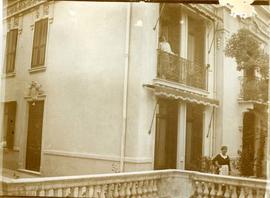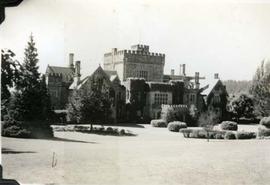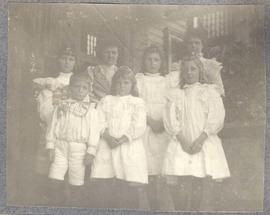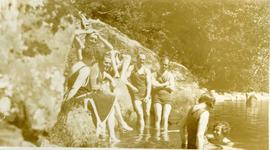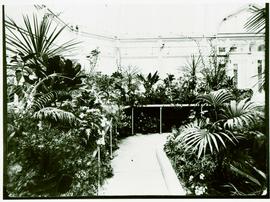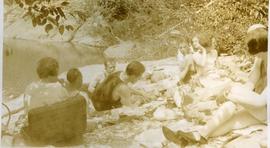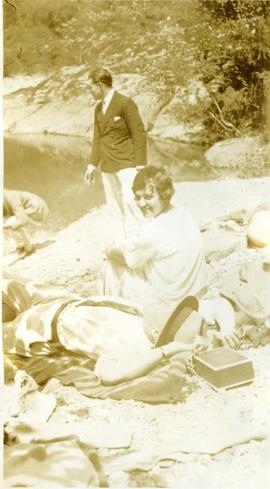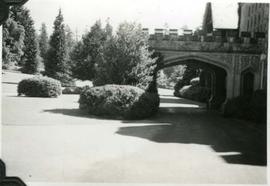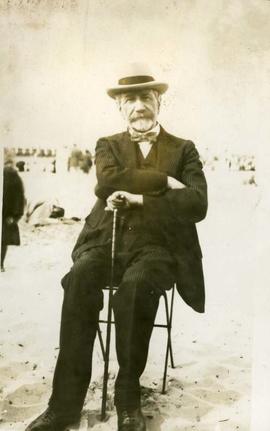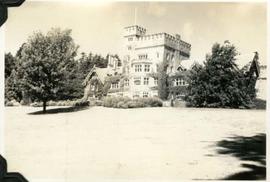The upper Japanese garden at Hatley Park was designed by Japanese landscape architect Isaburo Kashida. The garden was installed in 1909 and developed by Tadashi Noda from 1913-1927. Taken from the south shore of the pond, this image shows the pavilion reflected in the water as well as the castle behind.
Hatley Castle was designed by renowned British Columbia architect Samuel Maclure for James Dunsmuir. Using only the finest materials, builders, stonemasons and detail carpenters only took 18 months to construct the building from 1908 until 1910.
When Laura Dunsmuir died in 1937, the house and grounds were maintained by a skeleton staff until it was sold to the Canadian Government in 1940.
L to R, Back: Marion, Laura, Elinor, Byrdie. Front: James, Kathleen, Muriel
Dola Dunsmuir and Henry Cavendish are present. Henry 'Dish' Cavendish was married to Dola Dunsmuir from 1928 to 1934.
The greenhouse and conservatory were constructed and installed by the Lord and Burnham Company as part of the estate development by Brett and Hall between 1912 and 1914. The glass house complex had a full time manager and required 60 tons of coal and 200 cords of wood per year to heat. The ornate conservatory pictured had a central dome of about 30 ft square, with two side galleries, each 60 ft long. Flowers were grown inside that were intended for display in the castle and in later years it was also used for food production.
Henry Cavendish, married to Dola Dunsmuir from 1928 to 1934, is third from left
Hatley Castle was designed by renowned British Columbia architect Samuel Maclure for James Dunsmuir. Using only the finest materials, builders, stonemasons and detail carpenters only took 18 months to construct the building from 1908 until 1910.
When Laura Dunsmuir died in 1937, the house and grounds were maintained by a skeleton staff until it was sold to the Canadian Government in 1940.
Kathleen Dunsmuir is second from right.
The upper Japanese garden at Hatley Park was designed by Japanese landscape architect Isaburo Kashida. The garden was installed in 1909 and developed by Tadashi Noda from 1913-1927. A rustic wooden fishing bridge was positioned at the north end of the pond.
The upper Japanese garden at Hatley Park was designed by Japanese landscape architect Isaburo Kashida. The garden was installed in 1909 and developed by Tadashi Noda from 1913-1927.
The picture was taken on the eastern shore of the pond, looking north. The wooden floating wisteria arbour was replaced with a metal structure during the military college era.
Hatley Castle was designed by renowned British Columbia architect Samuel Maclure for James Dunsmuir. Using only the finest materials, builders, stonemasons and detail carpenters only took 18 months to construct the building from 1908 until 1910.
When Laura Dunsmuir died in 1937, the house and grounds were maintained by a skeleton staff until it was sold to the Canadian Government in 1940.
L to R: Maye, Elinor, Bessie, Muriel, Marion, Kathleen, James
James Jr., known as Boy by his immediate family, and born in January 1894, is dressed the same as his sisters. In the 19th century, boys and girls were dressed alike until aged about 4. At this time, boys would have a 'breeching ceremony' where their hair would be cut short and they would wear their first pair of trousers. Although less common by the end of the 1800s, the Dunsmuir family followed this tradition.
The upper Japanese garden at Hatley Park was designed by Japanese landscape architect Isaburo Kashida. The garden was installed in 1909 and developed by Tadashi Noda from 1913-1927.
The picture was taken on the eastern shore of the pond, looking north. The wooden floating wisteria arbour was replaced with a metal structure during the military college era.
Hatley Castle was designed by renowned British Columbia architect Samuel Maclure for James Dunsmuir. Using only the finest materials, builders, stonemasons and detail carpenters only took 18 months to construct the building from 1908 until 1910. The Italian garden to the west of the castle and the croquet lawn below was added as part of extensive development of the Hatley Park estate by Boston based landscape architects, Brett and Hall from 1912-1914.
When Laura Dunsmuir died in 1937, the house and grounds were maintained by a skeleton staff until it was sold to the Canadian Government in 1940.
L to R: Elinor, Kathleen, Muriel, Maye, Marion, James, Bessie
James Jr., known as Boy by his immediate family, and born in January 1894, is dressed the same as his sisters. In the 19th century, boys and girls were dressed alike until aged about 4. At this time, boys would have a 'breeching ceremony' where their hair would be cut short and they would wear their first pair of trousers. Although less common by the end of the 1800s, the Dunsmuir family followed this tradition.
second from left is possibly Dola Dunsmuir
Hatley Castle was designed by renowned British Columbia architect Samuel Maclure for James Dunsmuir. Using only the finest materials, builders, stonemasons and detail carpenters only took 18 months to construct the building from 1908 until 1910.
When Laura Dunsmuir died in 1937, the house and grounds were maintained by a skeleton staff until it was sold to the Canadian Government in 1940.
The upper Japanese garden at Hatley Park was designed by Japanese landscape architect Isaburo Kashida. The garden was installed in 1909 and developed by Tadashi Noda from 1913-1927.
This garden arch was in the upper Japanese garden.

